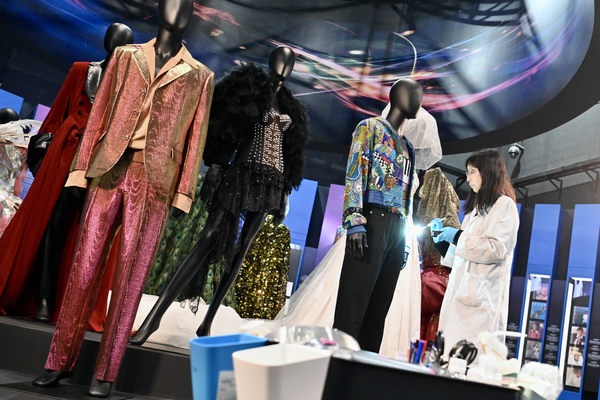Skilled Hands Keep HK History Alive

Legendary Cantopop singer Leslie Cheung’s futuristic seashell culottes worn during his Passion Tour concert in 2000 and singer Sam Hui’s sequin jacket worn when he went on stage at his Farewell Concert 1992, are just a couple of pieces of cultural property at the Heritage Museum that have been carefully preserved by skilled conservators for future generations to enjoy.
Meticulous work
Leisure & Cultural Services Department Assistant Curator I (Conservation) Angela Cheung has been working for the Conservation Office for more than 20 years and is mainly responsible for textiles conservation.
Wearing a lab coat and gloves, she can be seen pushing a cart full of conservation tools into the museum’s exhibition hall. Using a torch and magnifying glass, she carefully inspects the costumes, gently removing dust from them.
It took Miss Cheung more than a month to preserve Sam Hui's iconic costume.
“When the costume arrived at the museum, many bead strands were loose, so we used thread to reinforce them. The beads all over the costume make it heavy. When it is displayed vertically, it is subject to various tensions. We have to inspect it regularly to see if there are any problems,” she said.
Another conservator, Leisure & Cultural Services Department Assistant Curator II (Conservation) Annie Li, joined the Conservation Office about four years ago and specialises in preserving organic materials.
She preserved late singer Leslie Cheung’s awards and the red high heels he wore at his Live in Concert 97.
“They were previously stored in a shoebox and had been compressed, causing the straps to fall off. The exhibition designer wanted to showcase the high heels as they were worn, so we made an acrylic support and held up the straps with fishing line.”
Steady hands
When a cultural property arrives at the museum, it is first taken to the conservation laboratory for a full check.
Miss Cheung usually uses a microscope to closely examine the condition of a cultural property, and dyes or knits when necessary.
Having studied chemistry and material science at university, Miss Cheung said her scientific knowledge helps her understand the characteristics of a cultural property.
“Most of the materials used in the past were natural materials such as silk and cotton. Modern cultural objects are mostly made of synthetic fibres. You need to have an inquiring mind to think about how to handle various types of cultural property when they are starting to deteriorate.”
Miss Li also studied chemistry, which helps her choose the right conservation methods.
“Different adhesives have different melting points. For example, if a cultural property needs to be displayed outdoors, a different adhesive is used than if it were displayed indoors. This requires a knowledge of chemistry.”
In addition to having a solid scientific foundation, conservators must also possess patience, an attention to detail and high levels of concentration.
“You may have to work on a cultural property for a week, two weeks or even longer. It may seem like you are doing repetitive needlework, but the position of each needle must be adjusted according to the situation,” Miss Cheung explained.
While Miss Li added: “Conservation is a slow and meticulous process, so you need to have steady hands and be very careful.”
Professional training
To support the development of arts and culture, the 2022-23 Budget allocated $37 million to train conservators from the department and the Hong Kong Palace Museum in six years.
Miss Li recently took part in an overseas online course on the design and construction of exhibit mounts and learnt about measuring, tools and materials.
So far, the department has more than 50 people participating in 17 local or overseas professional conservation training courses.
Adaptive System Optimises Traffic Flow
In a bustling city like Hong Kong, waiting for traffic lights to change to green is an inevitable part of life, especi... Read more
Drone Sports Add To Low-altitude Buzz
Alongside the Government’s push to develop Hong Kong’s low-altitude economy, drone sports have been gaining in pop... Read more
Construction Robots Enhance Efficiency
For the Trunk Road T2 & Cha Kwo Ling Tunnel project, the Civil Engineering & Development Department has applie... Read more
HK's Smart Development Recognised
Hong Kong has placed significant emphasis on smart transformation and development in recent years – and its efforts ... Read more
Hotline Eases Carers' Burden
Mrs Lee, 74, and her 84-year-old husband are a doubleton elderly household relying on Comprehensive Social Security As... Read more
District Governance: Cameras Boost Security
Whether at busy intersections or tranquil street corners, Hong Kong has silent sentinels safeguarding citizens. Thr... Read more

